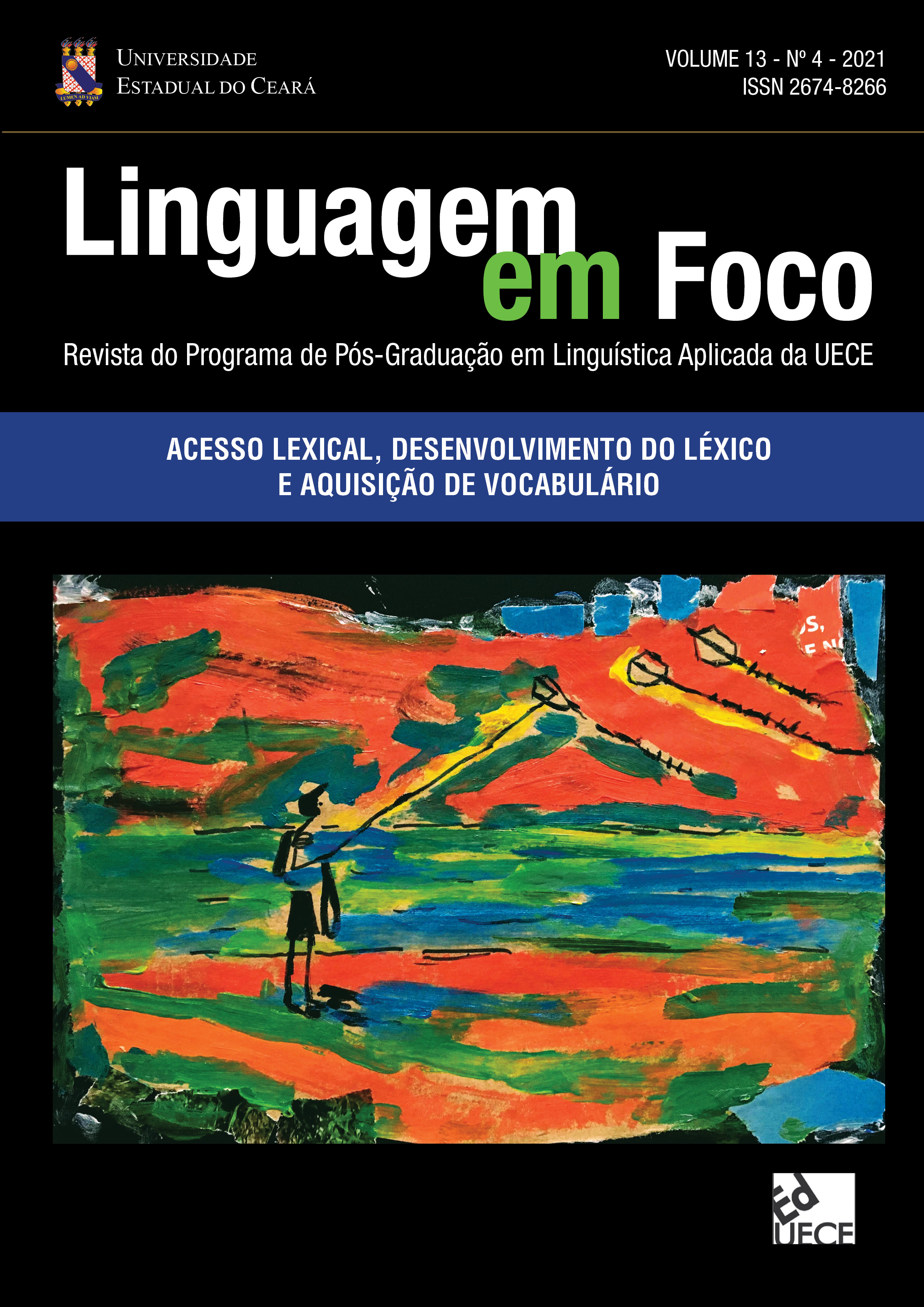Functionality of the N400 component and its application in studies of figurative language processing
A systematic review
DOI:
https://doi.org/10.46230/2674-8266-13-7263Keywords:
N400, Figurative processing, ERP, Metaphor, Idiom, Lexical accessAbstract
Electrophysiological studies have increased in the field of Neuroscience of Language as they allow for detailed analyses of the temporal course of language processing. In figurative language research, the most employed technique is Event Related Potentials (ERPs). The N400 is the most studied ERP component and is usually described as a marker of difficulty or effort in semantic processing. However, many controversial results about N400 have been found. Two main reasons can be raised for these results: (1) methodological difficulties in controlling psycholinguistic variables that are known to affect language processing and (2) different interpretations regarding what the N400 indexes. In this systematic review our main goals are: (1) providing a general panorama of studies on the N400 component applied to metaphoric and idiomatic language and (2) discussing the different views adopted by researchers regarding functional N400 theories and how ERP studies of figurative processing fit into each of those theories. We found two main interpretations about the process which is indexed by the N400: N400 as a marker of lexical access or as a marker of semantic integration. We also found that this dichotomy has an impact on the choice of models to explain the results about figurative language processing.
Downloads
References
ARZOUAN, Yossi; GOLDSTEIN, Abraham; FAUST, Miriam. Brainwaves are stethoscopes: ERP correlates of novel metaphor comprehension. Brain research, v. 1160, p. 69-81, 2007.
ARZOUAN, Yossi; GOLDSTEIN, Abraham; FAUST, Miriam. Dynamics of hemispheric activity during metaphor comprehension: Electrophysiological measures. Neuroimage, v. 36, n. 1, p. 222-231, 2007.
BAMBINI, Valentina et al. Disentangling metaphor from context: an ERP study. Frontiers in psychology, v. 7, p. 559, 2016.
BLOCK, Cady K.; BALDWIN, Carryl L. Cloze probability and completion norms for 498 sentences: Behavioral and neural validation using event-related potentials. Behavior research methods, v. 42, n. 3, p. 665-670, 2010.
CARROLL, DAVID W. Psychology of Language. 5ª ed. 2008.
COULSON, Seana; VAN PETTEN, Cyma. A special role for the right hemisphere in metaphor comprehension?: ERP evidence from hemifield presentation. Brain research, v. 1146, p. 128-145, 2007.
COULSON, Seana; VAN PETTEN, Cyma. Conceptual integration and metaphor: An event-related potential study. Memory & cognition, v. 30, n. 6, p. 958-968, 2002.
DE GRAUWE, Sophie et al. Electrophysiological insights into the processing of nominal metaphors. Neuropsychologia, v. 48, n. 7, p. 1965-1984, 2010.
DELONG, Katherine A.; URBACH, Thomas P.; KUTAS, Marta. Probabilistic word pre-activation during language comprehension inferred from electrical brain activity. Nature neuroscience, v. 8, n. 8, p. 1117-1121, 2005.
FORGÁCS, Bálint et al. Metaphors are physical and abstract: ERPs to metaphorically modified nouns resemble ERPs to abstract language. Frontiers in Human Neuroscience, v. 9, p. 28, 2015.
FORGÁCS, Bálint; LUKÁCS, Ágnes; PLÉH, Csaba. Lateralized processing of novel metaphors: disentangling figurativeness and novelty. Neuropsychologia, v. 56, p. 101-109, 2014.
GIBBS JR, Raymond W. Evaluating contemporary models of figurative language understanding. Metaphor and symbol, v. 16, n. 3-4, p. 317-333, 2001.
GIORA, Rachel. On the priority of salient meanings: Studies of literal and figurative language. Journal of pragmatics, v. 31, n. 7, p. 919-929, 1999.
GIORA, Rachel. Literal vs. figurative language: Different or equal?. Journal of pragmatics, v. 34, n. 4, p. 487-506, 2002.
GOLD, Rinat; FAUST, Miriam; GOLDSTEIN, Abraham. Semantic integration during metaphor comprehension in Asperger syndrome. Brain and Language, v. 113, n. 3, p. 124-134, 2010.
GOLDSTEIN, Abraham; ARZOUAN, Yossi; FAUST, Miriam. Killing a novel metaphor and reviving a dead one: ERP correlates of metaphor conventionalization. Brain and language, v. 123, n. 2, p. 137-142, 2012.
GRICE, Herbert P. Logic and conversation. In: Speech acts. Brill, 1975. p. 41-58.
HAGOORT, Peter; LEVINSON, Stephen C. Neuropragmatics. In: The cognitive neurosciences. MIT Press, 2014. p. 667-674.
IAKIMOVA, Galina et al. ERPs of metaphoric, literal, and incongruous semantic processing in schizophrenia. Psychophysiology, v. 42, n. 4, p. 380-390, 2005.
KEMMERER, David. Are the motor features of verb meanings represented in the precentral motor cortices? Yes, but within the context of a flexible, multilevel architecture for conceptual knowledge. Psychonomic Bulletin & Review, v. 22, n. 4, p. 1068-1075, 2015.
KUTAS, Marta; FEDERMEIER, Kara D. Thirty years and counting: finding meaning in the N400 component of the event-related brain potential (ERP). Annual review of psychology, v. 62, p. 621-647, 2011.
KUTAS, Marta; HILLYARD, Steven A. Reading senseless sentences: Brain potentials reflect semantic incongruity. Science, v. 207, n. 4427, p. 203-205, 1980.
KUTAS, Marta; HILLYARD, Steven A. Brain potentials during reading reflect word expectancy and semantic association. Nature, v. 307, n. 5947, p. 161-163, 1984.
LAI, Vicky Tzuyin; CURRAN, Tim; MENN, Lise. Comprehending conventional and novel metaphors: An ERP study. Brain research, v. 1284, p. 145-155, 2009.
LAKOFF, G. Metaphor and Thought. Cambridge University Press. 1979
LAKOFF, George; JOHNSON, Mark. Metaphors we live by. University of Chicago press, 1ª ed. 1980.
LAU, Ellen F.; PHILLIPS, Colin; POEPPEL, David. A cortical network for semantics:(de) constructing the N400. Nature reviews neuroscience, v. 9, n. 12, p. 920-933, 2008.
LAURENT, Jean-Paul et al. On understanding idiomatic language: The salience hypothesis assessed by ERPs. Brain Research, v. 1068, n. 1, p. 151-160, 2006.
LORUSSO, Maria Luisa et al. Processing sentences with literal versus figurative use of verbs: an ERP study with children with language impairments, nonverbal impairments, and typical development. Behavioural neurology, v. 2015, 2015.
LU, Aitao; ZHANG, John X. Event-related potential evidence for the early activation of literal meaning during comprehension of conventional lexical metaphors. Neuropsychologia, v. 50, n. 8, p. 1730-1738, 2012.
LUCK, Steven J. An introduction to the event-related potential technique. MIT press, 2014.
MA, Qingguo et al. Neural correlates of multimodal metaphor comprehension: evidence from event-related potentials and time-frequency decompositions. International Journal of Psychophysiology, v. 109, p. 81-91, 2016.
NIEUWLAND, Mante S.; VAN BERKUM, Jos JA. When peanuts fall in love: N400 evidence for the power of discourse. Journal of cognitive neuroscience, v. 18, n. 7, p. 1098-1111, 2006.
PROVERBIO, Alice M. et al. The role of left and right hemispheres in the comprehension of idiomatic language: an electrical neuroimaging study. BMC neuroscience, v. 10, n. 1, p. 1-16, 2009.
PYNTE, Joel et al. The time-course of metaphor comprehension: An event-related potential study. Brain and language, v. 55, n. 3, p. 293-316, 1996.
ROMMERS, Joost; DIJKSTRA, Ton; BASTIAANSEN, Marcel. Context-dependent semantic processing in the human brain: Evidence from idiom comprehension. Journal of Cognitive Neuroscience, v. 25, n. 5, p. 762-776, 2013.
RUTTER, Barbara et al. Can clouds dance? Part 2: An ERP investigation of passive conceptual expansion. Brain and Cognition, v. 80, n. 3, p. 301-310, 2012.
SANEI, Saeid; CHAMBERS, Jonathon A. EEG signal processing. John Wiley & Sons, 2007.
SCHMIDT-SNOEK, Gwenda L. et al. Auditory and motion metaphors have different scalp distributions: an ERP study. Frontiers in human neuroscience, v. 9, p. 126, 2015.
SCHNEIDER, Julie M. et al. Developmental differences in beta and theta power during sentence processing. Developmental Cognitive Neuroscience, v. 19, p. 19-30, 2016.
SCHNEIDER, Sabrina et al. Beyond the N400: Complementary access to early neural correlates of novel metaphor comprehension using combined electrophysiological and haemodynamic measurements. Cortex, v. 53, p. 45-59, 2014.
SOTILLO, María et al. Neural activity associated with metaphor comprehension: spatial analysis. Neuroscience letters, v. 373, n. 1, p. 5-9, 2004.
STRANDBURG, Robert J. et al. Event-related potential correlates of linguistic information processing in schizophrenics. Biological Psychiatry, v. 42, n. 7, p. 596-608, 1997.
TARTTER, Vivien C. et al. Novel metaphors appear anomalous at least momentarily: Evidence from N400. Brain and Language, v. 80, n. 3, p. 488-509, 2002.
THOMA, Patrizia; DAUM, Irene. Neurocognitive mechanisms of figurative language processing—evidence from clinical dysfunctions. Neuroscience & Biobehavioral Reviews, v. 30, n. 8, p. 1182-1205, 2006.
TROYER, Melissa; KUTAS, Marta. Harry Potter and the Chamber of What?: The impact of what individuals know on word processing during reading. Language, cognition and neuroscience, v. 35, n. 5, p. 641-657, 2020.
LAI, Vicky Tzuyin; CURRAN, Tim. ERP evidence for conceptual mappings and comparison processes during the comprehension of conventional and novel metaphors. Brain and Language, v. 127, n. 3, p. 484-496, 2013.
VESPIGNANI, Francesco et al. Predictive mechanisms in idiom comprehension. Journal of Cognitive Neuroscience, v. 22, n. 8, p. 1682-1700, 2010.
WEILAND, Hanna; BAMBINI, Valentina; SCHUMACHER, Petra B. The role of literal meaning in figurative language comprehension: Evidence from masked priming ERP. Frontiers in Human Neuroscience, v. 8, p. 583, 2014.
YANG, Jie; XUE, Jin. Spatial metaphor processing during temporal sequencing comprehension. Experimental brain research, v. 213, n. 4, p. 475, 2011.
ZHAO, Ming et al. The neuromechanism underlying verbal analogical reasoning of metaphorical relations: An event-related potentials study. Brain research, v. 1425, p. 62-74, 2011.
ZHOU, S.; ZHOU, W.; CHEN, X. Spatiotemporal analysis of ERP during Chinese idiom comprehension. Brain Topography, v. 17, n. 1, p. 27-37, 2004.
Published
How to Cite
Issue
Section
License
Copyright (c) 2022 Edgard Pereira Neves, André Mascioli Cravo, Maria Teresa Carthery-Goulart

This work is licensed under a Creative Commons Attribution 4.0 International License.
Authors who publish in Linguagem em Foco Scientific Journal agree to the following terms:
- Authors retain the copyright and grant the journal the right of first publication. The articles are simultaneously licensed under the Creative Commons Attribution License which allows sharing the work with an acknowledgement of its authorship and initial publication in this journal.
- The concepts issued in signed articles are the absolute and exclusive responsibility of their authors. Therefore, we request a Statement of Copyright, which must be submitted with the manuscript as a Supplementary Document.
- Authors are authorized to make the version of the text published in Linguagem em Foco Scientific Journal available in institutional repositories or other academic work distribution platforms (ex. ResearchGate, Academia.edu).





























